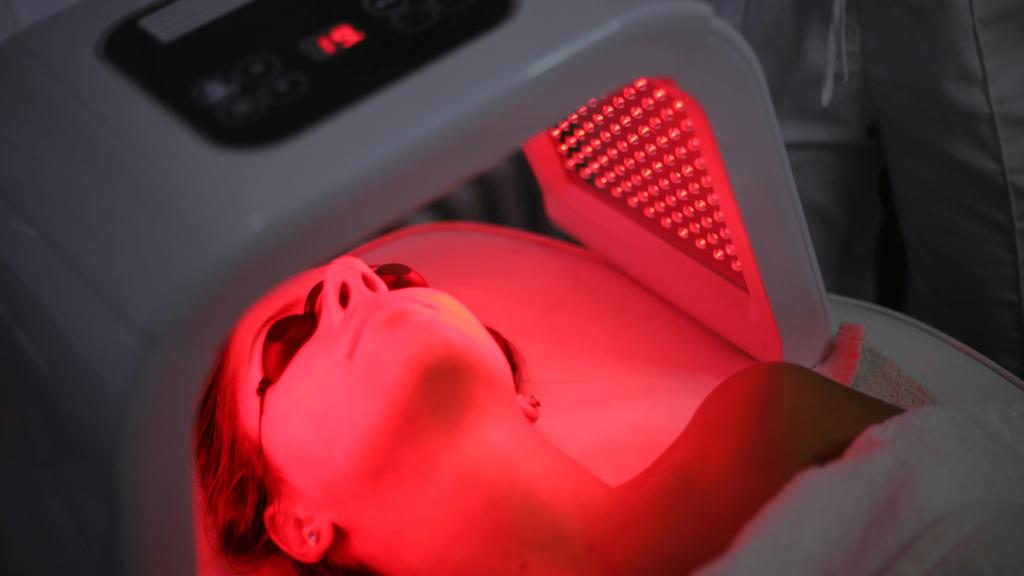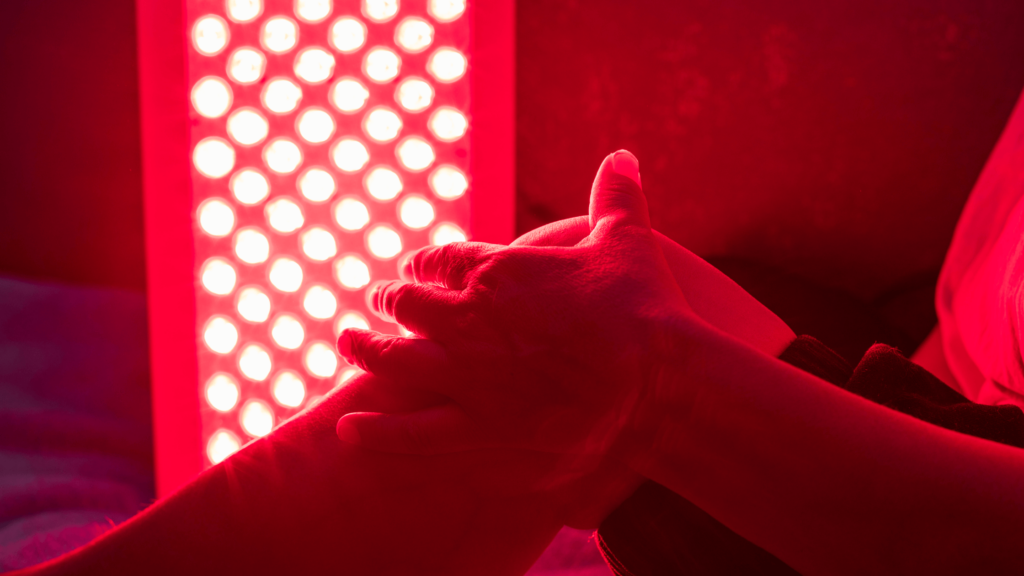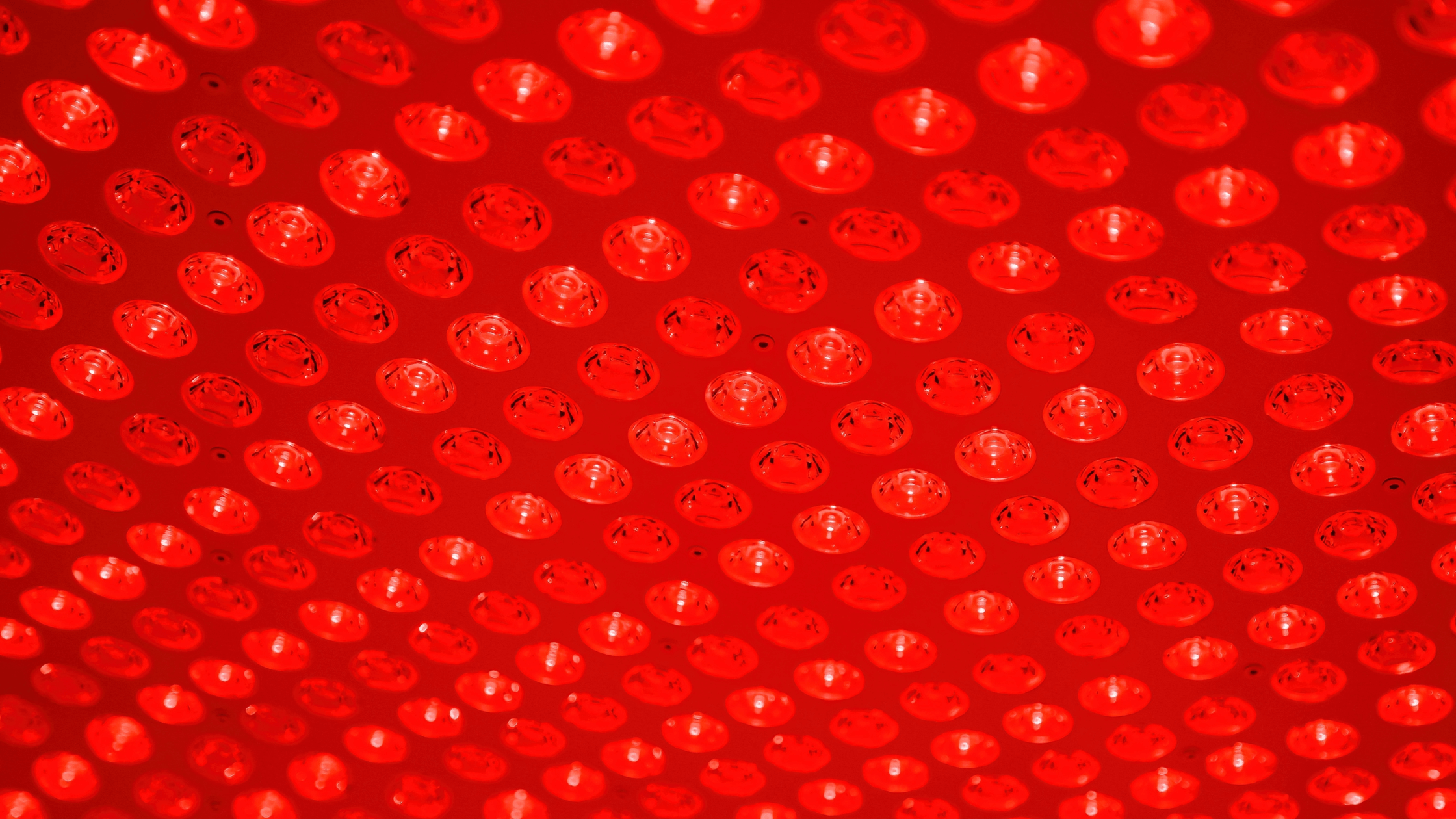Red light therapy (RLT) uses low-level wavelengths of light to stimulate your cells, helping your body heal and recharge faster. Whether you’re dealing with joint pain fatigue or just want to improve your overall health, RLT offers a powerful solution that’s especially beneficial for those in physically demanding jobs like construction.
What is red light therapy?

RLT is a non-invasive treatment that uses low-level red light to penetrate the skin and stimulate cellular function. NASA helped advance the technology for astronauts, and it’s now widely used across the healthcare and wellness sectors.
At a cellular level, RLT boosts mitochondrial activity at a cellular level, increasing ATP (adenosine triphosphate) production—cells’ energy currency. This process helps repair tissues, reduce inflammation, and improve cell function, leading to faster healing and recovery. The benefits of red light therapy are recognized across industries, from wound healing in hospitals to skin rejuvenation in spas.
Near-infrared vs. far-infrared
When discussing red light therapy, it’s essential to differentiate between near-infrared (NIR) and far-infrared (FIR) wavelengths, as each serves a different purpose.
- Near-infrared (NIR) wavelengths (typically 700-1100nm) are commonly used in red light therapy devices. NIR light penetrates the body, reaching muscles, tissues, and bones. This makes it highly effective for addressing deep-tissue issues like joint pain, muscle recovery, and improving blood circulation. Construction workers who deal with soreness or injuries that require deep tissue healing can benefit significantly from NIR’s ability to stimulate recovery beneath the skin’s surface.
- Far-infrared (FIR), on the other hand, operates at a much longer wavelength (3,000-10,000nm) and is primarily used in heat-based therapies, such as infrared saunas. FIR is absorbed by the skin’s surface, generating heat that helps with detoxification, superficial circulation, and relaxation. While FIR is excellent for heat therapy, it doesn’t offer the same light-based therapeutic benefits that NIR or red light wavelengths provide.
How red light therapy works
RLT operates by triggering your body’s natural healing processes at a cellular level. When red or near-infrared light penetrates the skin, it’s absorbed by the mitochondria, the energy-producing centers in your cells. This absorption boosts mitochondrial function, leading to an increase in ATP. With more energy, your body can repair tissues, reduce inflammation, and heal faster.
RLT also improves blood circulation by stimulating the production of new capillaries and increasing the flow of oxygen and nutrients to damaged areas. This boost in circulation helps accelerate recovery, reduce pain, and improve overall health. These mechanisms can be game-changers for construction workers who often deal with sore muscles, joint pain, and fatigue from physical labor.
Health benefits of red light therapy
Fights fatigue and increases energy
Red light therapy is known for its ability to boost energy by increasing the production of ATP in cells. This increased energy can make a significant difference for construction workers, who often experience physical exhaustion and long work hours. By helping your cells produce more ATP, RLT enables you to stay energized throughout the day, reducing the mid-day fatigue slump and keeping you productive from start to finish.
Boosts fat loss
RLT can also play a role in fat loss by stimulating your metabolism. Studies suggest that RLT helps break down fat cells by increasing blood flow and triggering the release of stored fat. While it’s not a replacement for a healthy diet and exercise, RLT can complement these efforts by giving your metabolism a little extra boost, which may help construction workers maintain a healthier body weight.
Supports muscle recovery
Muscle recovery is essential for anyone in a physically demanding job, and RLT can help speed up this process. By enhancing cellular energy production and blood flow, RLT promotes quicker muscle repair after strenuous activity. This means less downtime due to muscle soreness and faster recovery from heavy lifting or repetitive strain—ideal for construction workers who rely on their bodies daily.
Speeds up tissue repair and wound healing
Red light therapy can accelerate the healing process for cuts, bruises, and other minor injuries. By increasing blood flow and stimulating cell regeneration, RLT helps wounds close faster and reduces the risk of infection. For construction workers prone to minor injuries, using RLT can aid in quicker recovery and get you back on the job sooner.
May support mental health
Emerging research suggests that RLT may positively impact mental health by helping increase serotonin levels and improve mood. For those experiencing anxiety or depression, RLT’s ability to improve blood flow and reduce inflammation in the brain could help alleviate symptoms. While more research is needed, these findings offer a potential benefit for construction workers who may face mental strain or stress.
Improves hair growth
By promoting better blood circulation to the scalp and encouraging cellular repair, RLT can help with hair thinning or hair loss. This may be a surprising but welcome benefit for construction workers exposed to environmental stressors.
Enhances skin health
Whether exposed to the sun or the harsh conditions of a job site, construction workers’ skin can take a beating. RLT has been shown to improve skin tone, reduce the appearance of scars, and even help with conditions like acne. Its ability to promote collagen production makes RLT an effective tool for maintaining healthy, resilient skin.
Reduces pain and inflammation
RLT is a powerful tool for managing chronic pain and reducing inflammation, which is crucial for anyone dealing with the physical demands of manual labor. By targeting inflamed areas and increasing circulation, RLT helps reduce pain naturally, offering a non-invasive alternative to pain medications.
Improves joint health
Joint pain can be a major concern for construction workers, especially those with arthritis or repetitive strain injuries. RLT’s anti-inflammatory properties and ability to increase circulation make it an effective therapy for reducing joint pain and improving mobility. By supporting joint health, RLT can help workers stay active and pain-free for longer.
Ready to start red light therapy?

Getting started with red light therapy (RLT) is more accessible. You have two main options: buy your own device for at-home treatments or visit a clinic that offers RLT sessions. Both options have advantages, so it comes down to your preference, budget, and convenience.
Home devices
Home RLT devices come in various sizes and prices, ranging from handheld devices for spot treatments to larger panels for full-body exposure. These are great options if you want the flexibility of using RLT regularly without scheduling appointments or leaving your home. For optimal results, look for a device that offers wavelengths between 600 and 900nm.
Some great brands to check out: KALA, Hooga, Solawave, JOOV, Infraredi
Visiting a clinic
If you’re not ready to invest in your own device, many wellness centers, spas, and even some physical therapy clinics offer RLT sessions. This option allows you to try professional-grade equipment without committing to a purchase. Sessions usually last between 10 and 20 minutes, and you can discuss your specific needs with a practitioner to get the most out of your treatment.
General guidelines for timing and dosing
When starting RLT, it’s important to get the timing and dosage right. Sessions lasting 5-20 minutes are recommended for most people, depending on the area you’re treating and the device’s intensity. You can start with shorter sessions (about 5-10 minutes) and gradually increase the time as your body adjusts.
Consistency is critical for seeing benefits, so aim for 3-5 weekly sessions. Whether you’re targeting muscle recovery, joint pain, or skin health, regular exposure to red light can help you see improvements over time.
With either method, it’s important to follow the device’s instructions or consult a professional to avoid overexposure. RLT is generally safe, but as with any therapy, moderation is essential.
Red light therapy safety
RLT is safe for most people when used correctly, but there are a few precautions to follow:
- Eye protection: Always wear protective goggles, as direct exposure to the light can harm your eyes.
- Skin sensitivity: If you have sensitive skin, start with shorter sessions to avoid irritation, gradually increasing exposure as your skin adjusts.
- Device quality: Choose high-quality devices from reputable manufacturers with wavelengths between 600 and 900 nm for the best results.
- Timing: Stick to the recommended session times (5-20 minutes) to avoid overexposure. More exposure will not improve results and could cause mild irritation.
- Special conditions: If you’re pregnant, sensitive to light, or have serious medical conditions, consult your doctor before starting RLT.
Bottom line
Whether you want to enhance your energy, reduce pain, or speed up recovery, red light therapy (RLT) offers many benefits beyond the surface. For construction workers facing daily physical demands, RLT can improve joint health, accelerate muscle recovery, and even support mental well-being. Its ability to promote skin health and hair growth and reduce inflammation makes it a versatile tool for overall health and wellness. With regular use, RLT can help you stay stronger, recover faster, and feel your best on and off the job.


